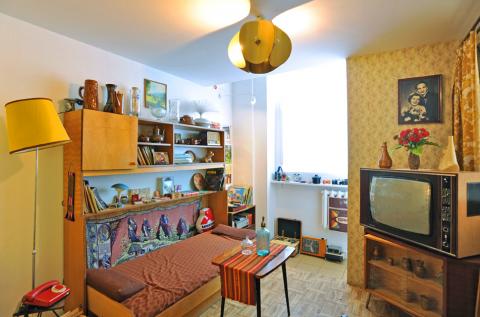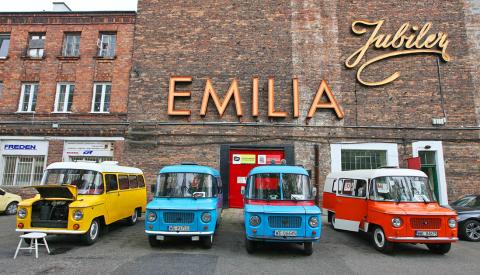There is no love lost in Poland for the bygone communist system, but those who think they have missed something unusual still have a chance to experience the austerity and subdued atmosphere of life in those times.
A life-under-communism museum in Warsaw offers tours of communist-era architecture, a look at a typical small apartment, a taste of cherry vodka and a ride in a militia van. Foreign tourists come here out of curiosity, Polish schoolchildren come to learn about those not-so-distant times that their parents grew up in, and parents and grandparents come out of nostalgia for their youth.
The museum, called The Charm of PRL (the People’s Republic of Poland), offers “Warsaw Experience” guided tours, in English and in other languages.

Photo: AP/ Alik Keplicz
Arranged in an old, bleak warehouse in a backstreet in Warsaw’s gritty Praga district, the tour offers a glimpse of more than four decades of life behind the Iron Curtain, under an oppressive system that was directed from Moscow. After communism was imposed on Poland following World War II, the country experienced persecution, deprivation and bans, often bordering on the absurd. The Poles, led by the massive Solidarity freedom movement, voted the system out in 1989 elections.
Inside the museum, visitors see a typical, modest one-bedroom apartment with simple, Polish or East Bloc-made house appliances, a typical office of a local party secretary with the communist leaders’ portraits and a hotline phone. In another spot, bust figures of Lenin and Marx, and an old radio serve as reminders that the communists were jamming Radio Free Europe and Voice of America, which the Poles secretly tuned into for true news.
VODKA OUT OF TRAGEDY

Photo: AP/ Czarek Sokolowsk
“We were there (under communism) for 45 years,” the museum’s driver-guide Mariusz Nurkiewicz said in English. “For example, my parents, they were young, they fall in love, I was born...So this is that sentimental feel to youth, to the past, more than to communism, to system. Nothing was too good about the system, but about the life, we were still trying to be happy.”
For a moment of respite, the visitors are invited to a bar to sample simple biscuits or wafers, enhanced by a toast of cherry vodka. Nearby stands a phone booth, with no phone inside, just as it sometimes was in communist times.
Nathan Hanson, a tourist from Dubuque, Iowa, said he has “always regretted not seeing anything Soviet before the Soviet Union fell. And I know remnants of that are quickly disappearing and so I booked the communism tour today to see what I could, to see what’s left.”
His conclusion from the tour was that the society in Poland is “changing very quickly.”
“It’s just fascinating to look back in time,” Hanson said. “It’s a big part of my generation with the conflict with the US and the Soviet Union, so it’s really neat to just get a peek of what it looked like.”
The visitors can also take a ride in a no-comfort Polish-made van used by the militia in the 60s and 70s to transport criminal and political detainees. For some US$42 per person, an English-speaking driver-guide will take them to see typical architecture of the time, including Poland’s tallest building, the Palace of Culture and Science, a 1955 gift from Soviet leader Joseph Stalin. It survived a cathartic push to have it torn down just after the ouster of communism, and celebrates its 60th birthday this year.
“We would see some of the architecture of that time which is called socialist realism (and) admire the figures of the working class, because all that system was built, was created, for the happiness of the working class,” Nurkiewicz said.
He jokingly said that he tries to get tourists join the Communist party.
“No, I’m just kidding of course. We are happy here in Poland (that) the communism is over.”

Feb. 17 to Feb. 23 “Japanese city is bombed,” screamed the banner in bold capital letters spanning the front page of the US daily New Castle News on Feb. 24, 1938. This was big news across the globe, as Japan had not been bombarded since Western forces attacked Shimonoseki in 1864. “Numerous Japanese citizens were killed and injured today when eight Chinese planes bombed Taihoku, capital of Formosa, and other nearby cities in the first Chinese air raid anywhere in the Japanese empire,” the subhead clarified. The target was the Matsuyama Airfield (today’s Songshan Airport in Taipei), which

On Jan. 17, Beijing announced that it would allow residents of Shanghai and Fujian Province to visit Taiwan. The two sides are still working out the details. President William Lai (賴清德) has been promoting cross-strait tourism, perhaps to soften the People’s Republic of China’s (PRC) attitudes, perhaps as a sop to international and local opinion leaders. Likely the latter, since many observers understand that the twin drivers of cross-strait tourism — the belief that Chinese tourists will bring money into Taiwan, and the belief that tourism will create better relations — are both false. CHINESE TOURISM PIPE DREAM Back in July

Could Taiwan’s democracy be at risk? There is a lot of apocalyptic commentary right now suggesting that this is the case, but it is always a conspiracy by the other guys — our side is firmly on the side of protecting democracy and always has been, unlike them! The situation is nowhere near that bleak — yet. The concern is that the power struggle between the opposition Chinese Nationalist Party (KMT) and their now effectively pan-blue allies the Taiwan People’s Party (TPP) and the ruling Democratic Progressive Party (DPP) intensifies to the point where democratic functions start to break down. Both

This was not supposed to be an election year. The local media is billing it as the “2025 great recall era” (2025大罷免時代) or the “2025 great recall wave” (2025大罷免潮), with many now just shortening it to “great recall.” As of this writing the number of campaigns that have submitted the requisite one percent of eligible voters signatures in legislative districts is 51 — 35 targeting Chinese Nationalist Party (KMT) caucus lawmakers and 16 targeting Democratic Progressive Party (DPP) lawmakers. The pan-green side has more as they started earlier. Many recall campaigns are billing themselves as “Winter Bluebirds” after the “Bluebird Action”